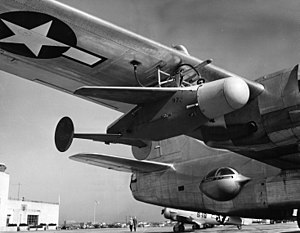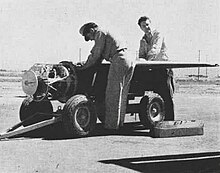ASM-N-2 Bat
| ASM-N-2 Bat | |
|---|---|
 Bat guided bomb mated to PB4Y Privateer | |
| Type | Conventional |
| Place of origin | United States |
| Service history | |
| In service | 1945 (Bomb MK 57)[1] – 1953 (ASM-N-2) |
| Used by | United States Navy |
| Wars | World War II |
| Production history | |
| Manufacturer | National Bureau of Standards |
| No. built | 2,580[2] |
| Specifications | |
| Mass | Airframe and guidance package only – 600 pounds (270 kg) |
| Length | 11 feet 11 inches (3.63 m) |
| Width | 10 feet (3.0 m) |
| Filling weight | 1,000 lb bomb (1,600 lb (727 kg) gross) |

The ASM-N-2 Bat was a United States Navy World War II radar-guided glide bomb[3][4] which was used in combat beginning in April 1944. It was developed and overseen by a unit within the National Bureau of Standards (which unit later became a part of the Army Research Laboratory) with assistance from the Navy's Bureau of Ordnance, the Massachusetts Institute of Technology, and Bell Telephone Laboratories.[5] It is considered to be the first fully automated guided missile used in combat.[6]
Background[edit]
In January 1941 RCA proposed a new TV-guided anti-shipping weapon, called Dragon, for which an operator would use the TV image sent from the nose of the weapon and operate aerodynamic controls during the weapon's fall. The National Bureau of Standards (NBS) would provide the airframe for use with a standard bomb, and was the same guidable ordnance airframe design used for the earlier, abortive Project Pigeon weapons program. The Pelican was a June 1942 modification using semi-active radar homing. By mid-1943, a modification of the design was proposed to use a new active radar homing system from Western Electric with a 2,000-pound (907 kg) (one short ton) general-purpose (GP) bomb, the same basic "AN-M66" ordnance unit as used for the heavier USAAF VB-2 version of the Azon radio-controlled ordnance. This Pelican version entered testing in summer 1944 at Naval Air Station New York, where it hit its target ship in two out of four drops.
Development[edit]
The Bat was the production version which combined the original NBS airframe with a 1,000-pound (454 kg) AN-M65 GP bomb, the same basic ordnance that was used in the contemporary Azon guided munition, and the Pelican active radar system.[7] Gyrostabilized with an autopilot supplied by Bendix Aviation, the steerable tail elevator was powered by small wind-driven generators. The Navy's Bureau of Ordnance[7] in partnership with the Massachusetts Institute of Technology (MIT) supervised development and the NBS was in charge of the overall development. Flight tests were conducted at the Naval Air Ordnance Test Station at Chincoteague Island, Virginia. Hugh Latimer Dryden won the President's Certificate of Merit for the development of the Bat,[3] which "was flight tested by a small unit based at Philadelphia against targets in New Jersey."[8] While the NBS developed the Bat's aerodynamic and gyroscopic stabilizing systems, MIT and Bell Labs worked together on its guidance mechanism.[6]
Deployment[edit]

The antiship variant of the Bat (SWOD, for "Special Weapons Ordnance Device",[9] Mark 9 Modification 0) eventually saw combat service beginning in April 1945 off Borneo, dropped by Consolidated PB4Y Privateers[7] (one bomb mounted under each wing) at altitudes of 15,000 to 25,000 feet (4,600 to 7,600 metres) at airspeeds of 140 to 210 kn (260 to 390 km/h). Several Japanese ships were sunk and the kaibokan Aguni was damaged from a range of 20 nmi (37 km).This vessel is frequently misreported as having been sunk by a destroyer.[10] Several Bats were also fitted with modified radar systems (SWOD Mark 9 Model 1) and dropped on Japanese-held bridges in Burma – the same targets that the MCLOS-guidance, half-ton (AN-M65 GP bomb) weight VB-1 Azon PGM ordnance was designed to take on – and other land-based targets. The Bat's pioneering radar guidance system was easily confused by radar land clutter, particularly against targets close to shore. A total of approximately 2,600 Bat missiles were deployed.[6]
After the war, the naval designation ASM-N-2 was applied to the unit.
The Privateer was the primary launch platform for the Bat, but other aircraft were also modified to launch the weapon, including the Vought F4U Corsair, Curtiss SB2C Helldiver, and Grumman TBF Avenger. The primary post-World War II aircraft to carry the weapon was the P2V Neptune.
Existing missiles[edit]
The original NBS test airframe of the Bat was renovated in 2001 to resemble the real missile and is currently on display at the museum of the National Institute of Standards and Technology,[11] the successor to the earlier US National Bureau of Standards. Another example is on display at the Pima Air & Space Museum in Tucson, Arizona.[12]
See also[edit]
- Fritz X
- Henschel Hs 293
- Ruhrstahl X-4
- Azon
- VB-6 Felix
- McDonnell LBD-1 Gargoyle
- Project Pigeon
- GB-8
- Kawasaki Ki-147 I-Go Type1 - Ko
- Kawasaki Ki-148
- Ke-Go
Related lists
References[edit]
- ^ "ASM-N-2". Directory of U.S. Military Rockets and Missiles. Archived from the original on 13 November 2007. Retrieved 24 December 2007.
- ^ Kopp, Dr Carlo. "The Dawn of the Smart Bomb". Air Power Australia. Retrieved 24 December 2007.
- ^ a b "Missile, Air-to-Surface, Bat". Rockets and Missiles. Smithsonian National Air and Space Museum. Archived from the original on 7 May 2009. Retrieved 12 May 2009.
- ^ Newman, Michael E. "Students Help Renovate a Part of WWII-and NIST-History". NIST Tech Beat – February 2001 – Preservation. National Institute of Standards and Technology. Archived from the original on 2 April 2015. Retrieved 19 March 2015.
- ^ Sweeney, Jim (January 2002). "Restoration: The Bat". Air & Space Magazine. Retrieved 13 July 2018.
- ^ a b c Materese, Robin (20 June 2017). "Giving New Wings to an Old Bat". NIST. Retrieved 13 July 2018.
- ^ a b c Fahrney, Delmar S., RADM USN (December 1980). "The Birth of Guided Missiles". United States Naval Institute Proceedings. p. 60.
{{cite web}}: CS1 maint: multiple names: authors list (link) - ^ Merrill, Capt Grayson (n.d.). "Innovation Wins Wars". Your story – Class of 1934. USNA Alumni Association and Foundation. Retrieved 7 January 2013.
BAT was flight tested by a small unit based at Philadelphia against targets in New Jersey.
- ^ SWOD
- ^ "Japanese Escorts".
- ^ "The Bat Missile". NIST. Archived from the original on 27 May 2010. Retrieved 7 June 2010.
- ^ "Designation: ASM-N-2". Pima Air & Space Museum. Retrieved 6 July 2023.
